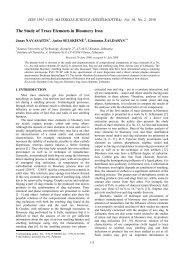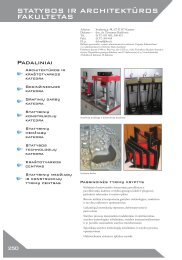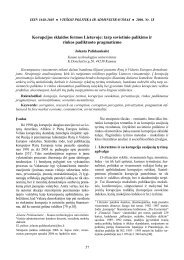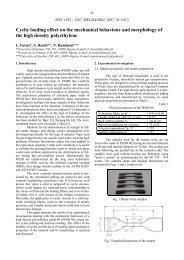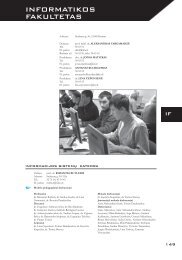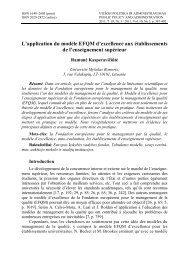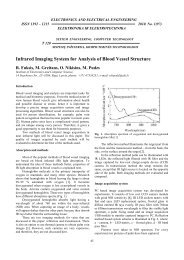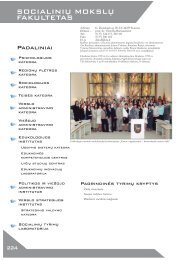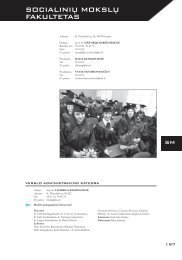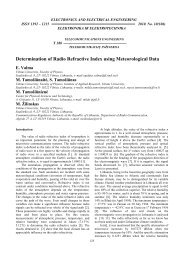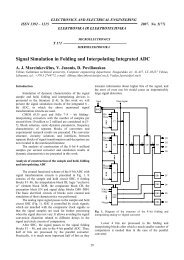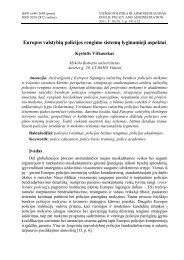Multi-criteria Optimization System for Decision Making - Kauno ...
Multi-criteria Optimization System for Decision Making - Kauno ...
Multi-criteria Optimization System for Decision Making - Kauno ...
- No tags were found...
You also want an ePaper? Increase the reach of your titles
YUMPU automatically turns print PDFs into web optimized ePapers that Google loves.
ISSN 1392-2785 ENGINEERING ECONOMICS. 2009. No 1 (61)ECONOMICS OF ENGINEERING DECISIONS<strong>Multi</strong>-<strong>criteria</strong> <strong>Optimization</strong> <strong>System</strong> <strong>for</strong> <strong>Decision</strong> <strong>Making</strong> in Construction Designand ManagementZenonas Turskis 1 , Edmundas Kazimieras Zavadskas 1 , Friedel Peldschus 21 Vilniaus Gedimino technikos universitetasSaulėtekio al. 11, LT-10223, Vilnius2 Leipzig University of Applied SciencesKarl-Liebknecht street 132, 04277 LeipzigAll new ideas and possible variants of decisions mustbe compared according to many <strong>criteria</strong>. The complexnature of decision-making requires practitioners to selectinvestment options based on a wider variety of policyconsiderations in addition to cost benefit analysis and puretechnical considerations. In economics and decisionmaking it is essential to be able to take into account theimpacts of cultural, social, moral, legislative, demographic,economic, environmental, governmental and technologicalchange, as well as changes in the business world oninternational, national, regional and local markets. Costbenefit analysis approach is a useful tool <strong>for</strong> investmentdecision-making from an economic perspective. Cautionsshould also be given to the methods of determining thevalue of social and local interests. Some socialexternalities, such as employment and regional economicimpacts, are generally omitted in current practices.Current practices tend to use cardinal or ordinal scales inmeasure in non-monetized <strong>criteria</strong>. The use of unreasonablemonetization methods in some cases has discredited costbenefit analysis in the eyes of decision makers and thepublic. It may be appropriate to consider these externalities inqualitative <strong>for</strong>ms in a multi-<strong>criteria</strong> analysis. <strong>Multi</strong>-<strong>criteria</strong>decision making is used in various areas of humanactivities. The Criteria can be qualitative and quantitative.They usually have different units of measurement anddiffer in optimization direction. The normalization aims atobtaining comparable scales of <strong>criteria</strong> values. In the newversion of the program LEVI 4 the normalization methodsare including vector, linear scale, non-linear and newlogarithmic techniques may be used. This softwareconsiders the main aspects of two-sided game problems.The following strategic principles are used: Wald's rule,Savage criterion, Hurwicz's rule, Laplace's rule, Bayes'srule and Hodges-Lehmann rule. This program isdemonstrated by considering a real case study involving 4evaluation <strong>criteria</strong> of the currently used external walls ofindividual residential buildings.Keywords: construction, optimization, multi-<strong>criteria</strong>, gametheory, two-sided problem, normalization,logarithmic, software.IntroductionThe research problem. Economics and managementdevelop very rapidly with other scientific directions(Martinkus, 2006). All developments and changes requiremethods to evaluate them. All new ideas and possiblevariants of decisions must be compared according to many<strong>criteria</strong>. Each decision-maker has own interests and isalways interested in states of environment factor(Christauskas and Stungurienė, 2007). Many researchers(Zavadskas and Vilutiene 2006; Turskis, 2008; Kalibatasand Turskis, 2008) have pointed out that in economics anddecision making it is essential to be able to take intoaccount the impacts of cultural, social, moral, legislative,demographic, economic, environmental, governmental andtechnological change, as well as changes in the businessworld on international, national, regional and local realestate markets. There<strong>for</strong>e, after the popularity of costbenefit analysis (Susnienė and Vanagas, 2007) and relatedengineering economic evaluation techniques, there was anincreasing popularity of multi-<strong>criteria</strong> analysis, which iscapable of dealing with the multiple dimensions ofevaluation problems. These techniques aim to solveconflicting social, environmental, political and economicissues in modern decision-making. <strong>Multi</strong>-<strong>criteria</strong> decisionmakingmethods intuition is closely related to the wayhumans have always been making decisions. Consequently,despite the diversity of multi-<strong>criteria</strong> decision-makingmethods approaches, methods and techniques, the basicideas of multi-<strong>criteria</strong> decision-making methods are verysimple: a finite or infinite set of actions (alternatives,solutions, courses of action ...), at least two <strong>criteria</strong>, and,obviously, at least one decision-maker. Given these basicelements, multi-<strong>criteria</strong> decision-making methods are anactivity which helps making decisions mainly in terms ofchoosing, ranking or sorting the actions.The purpose of the article. The idea of multi-<strong>criteria</strong>decision-making methods is so natural and attractive thatthousands of articles and books have been devoted to thesubject, with many scientific journals regularly publishingarticles about multi-<strong>criteria</strong> decision-making methods. Themain ideas are well established there.The last decade saw a great increase in application ofmulti-<strong>criteria</strong> decision making methods application inconstruction and management. Analytic Hierarchy Process(AHP) has been a tool in the hands of decision makers andresearchers since its invention; it is still one of the mostwidely used multi-<strong>criteria</strong> decision-making methods. Manyoutstanding works including applications of AHP indifferent fields have been published based on AHP. AHP- 7 -
and its numerical extensions are flexible enough to beintegrated with different techniques like Linear Programming,Quality Function Deployment, Fuzzy Logic, etc. Thisenables the user to extract benefits from all the combinedmethods, and, hence, achieve the desired goal in a betterway. Skibniewski (1992) applied this method to theselection of rational construction technology. Hsueh et al.(2007) used AHP method. The authors argue that using theutility function to set up an assessment model shows theadvantages of the method and it can not only overcome thedifficulties of building a multi-<strong>criteria</strong> model but also helpdecision-makers to adjust it properly according to theirpreference and attitude risk in order to reduce inconsistentdecisions influenced by various factors, such as emotion,environment, in<strong>for</strong>mation, etc. This study presents a novelprocedure <strong>for</strong> determining construction project budgets.Lai et al. (2008) proposed a procedure <strong>for</strong> integrating theAHP - based multi-<strong>criteria</strong> evaluation model with asimulation-based cost model. First, a set of budgetevaluation <strong>criteria</strong> and their associated weights <strong>for</strong> publicbuilding construction projects were established via aquestionnaire survey and application of AHP, respectively.Using the same <strong>criteria</strong> and weights, they per<strong>for</strong>medconsistent evaluation of budgets <strong>for</strong> different projects. Suet al. (2006) proposed a revised method by applying MonteCarlo simulation analysis to rank the major transportprojects. They determined implementation priorities andbudget allocations which were derived from the AHP anddirect subjective rankings to set funding priorities.Ugwu et al. (2006a, 2006b) discussed the developmentof key per<strong>for</strong>mance sustainability indicators, computationalmethods, and analytical models <strong>for</strong> achieving sustainabilityin infrastructure projects. They used the ‘weighted summodel’ technique in multi-<strong>criteria</strong> decision analysis and the‘additive utility model’ in AHP <strong>for</strong> multi-<strong>criteria</strong> decisionmaking to develop the model based on the outlined one.Wong et al. (2008) research was conducted towardsaiding in decisions and appraisal of building systems andcomponents in the intelligent building. The authors aimedto identify the key intelligent indicators and map analyticaldecision models <strong>for</strong> intelligence appraisal of the intelligentbuilding systems. A total of 69 key intelligence <strong>criteria</strong>were identified <strong>for</strong> eight major intelligent buildingsystems. Two multi-<strong>criteria</strong> decision making approaches,the AHP and analytic network process (ANP), wereemployed in this study to evaluate the intelligence level ofthe intelligent building systems.Kauko (2007) developed a pairwise comparison procedureof the house buyers’ or renters’ <strong>criteria</strong> based on expertjudgements and the AHP. The author‘s study is based onexpert elicited residential location quality profiles in thecity, and builds on prior work on housing market analysisreported elsewhere. Several authors (Zavadskas, 1990;Ugwu 2006a, 2006b; Hsueh et al. 2007) applied the utilitytheory methods to select rational alternatives in construction.Zavadskas (1986, 1987), Zavadskas and Antucheviciene(2006), Zavadskas et al. (2006), Ginevicius and Podvezko(2008), Ginevicius et al. (2008), Ustinovichius et al. (2007),Lin et al. (2008), and other authors applied TOPSISmethod in construction.The multi-<strong>criteria</strong> decision making method COPRASwas first announced in 1994 by Zavadskas and Kaklauskas(1999). This method assumes direct and proportionaldependence of the significance and utility degree of theinvestigated versions on a system of <strong>criteria</strong> adequatelydescribing the alternatives and values and weights of the<strong>criteria</strong>. Many problems of alternatives’ ranking anddecision assessment in construction have been solved byapplying this method (Viteikiene and Zavadskas, 2007;Kaklauskas et al, 2007; Zavadskas et al, 2008; Kaklauskaset al, 2006; Kaklauskas et al, 2005; Zavadskas et al, 2007;Banaitiene et al, 2008).Fuzzy AHP (Lin et al., 2008), fuzzy TOPSIS (Wangand Elhag, 2006), fuzzy COPRAS (Zavadskas andAntucheviciene, 2007) and game theory (Perng et al, 2005)methods can be applied in the cases of uncertainty. Thenumber of cases based on the game theory application <strong>for</strong>solving construction problems and of the papers dealingwith this method is very small. This paper presents adecision support system based on game theory applicationintended <strong>for</strong> problem solution in construction design andmanagement.A review of standard decisions made in engineering,management and economy has shown that the evaluationof all possible actions is not always sufficient (Zavadskasand Vaidogas, 2008). Each action may lead to several,sometimes conflicting results. As the actual outcome is notknown, the <strong>criteria</strong> taking into consideration all possibleresults are needed. There<strong>for</strong>e, multi-<strong>criteria</strong> decisionmaking becomes extremely important.The main objective of this research is – apply GameTheory, well known normalization and newly proposedlogarithmic normalization method in software.Research tasks. The main steps of multiple <strong>criteria</strong>decision making are as follows:a) generating a set of evaluation <strong>criteria</strong> that relatesystem capabilities to goals;b) developing alternative systems <strong>for</strong> attaining thegoals (generating alternatives);c) evaluating alternatives in terms of <strong>criteria</strong> (thevalues of the criterion functions);d) applying a normative multiple <strong>criteria</strong> method ofanalysis;e) accepting one alternative as "optimal" (preferable);f) if the final solution is not accepted, gather newin<strong>for</strong>mation and go into the next iteration of multiple <strong>criteria</strong>optimization.Any problem to be solved is represented by a matrixcontaining the alternatives (rows) and the <strong>criteria</strong> (columns).An alternative in multi-<strong>criteria</strong> evaluation is usuallydescribed by quantitative and qualitative <strong>criteria</strong>. Usually,the <strong>criteria</strong> have different dimensions. In order to avoid thedifficulties caused by different dimensions of the <strong>criteria</strong>,the ratio <strong>for</strong> a particular value is used. There are varioustheories describing the ratio <strong>for</strong> a particular value. However,the values are mapped either on the interval [0; 1] or theinterval [0; ∞ ] by applying the normalization of a decisionmakingmatrix. When the normalization is completed, it ispossible to evaluate the <strong>criteria</strong> with weightingfactors 0 p q jp 1 . The sum of the weighting factors shouldbe equal to 1.The impact of the decision matrix normalizationmethods on the decision results has been investigated by- 8 -
many authors (Weitendorf, 1976; Hwang and Yoon, 1981;Peldschus et al., 1983; Peldschus, 1986; Stopp, 1975;Jüttler and Körth, 1969; Brauers and Zavadskas, 2006;Brauers et al, 2007; Zavadskas et al, 2003; Van Delft andNijkamp, 1977; Zavadskas and Turskis, 2008; Peldschus,2007; Peldschus et al, 2002). The authors of many wellknownprograms chose a particular problem solutionmethod and a particular approach to decision-makingmatrix normalization. There are still no rules determiningthe application of multi-<strong>criteria</strong> evaluation methods andinterpretation of the results obtained.The novelty of the article. Vilnius GediminasTechnical University (VGTU) and Leipzig University ofApplied Sciences (HTKW) have been investigating theapplication of game theory principles to civil engineeringtechnology and management problems <strong>for</strong> more than 25years (Peldschus et al, 1983; Peldschus et al, 2002;Peldschus, 2007, 2008; Peldschus and Zavadskas, 1997;Peldschus and Zavadskas, 2005; Zavadskas et al, 1994;Zavadskas et al, 2003; Zavadskas et al, 2004; Zavadskasand Turskis, 2008). The program LEVI 3.0 was a result of.the co-operation between VGTU and HTKW. The programLEVI 4 was modified <strong>for</strong> evaluating various processes ineconomics, engineering and management.All calculations were made with LEVI 4 (Peldschus etal, 2002; Peldschus and Zavadskas, 2005; Zavadskas et al,2002; Zavadskas et al, 2003). In the new program versionLEVI 4 (Figure 1 and Table 1) a new logarithmicnormalization method is implemented. This new softwareallows us to find a solution under the conditions of risk anduncertainty and to compare the results by applyingdifferent methods. Scientific novelty of this research –newly proposed logarithmic normalization method isapplied in a new version of the program. Game Theory isapplied <strong>for</strong> multi-<strong>criteria</strong> assessment of external walls.The object of the research is developing and applyingof the multi-<strong>criteria</strong> optimization system <strong>for</strong> decisionmaking in construction design and management.The methods of the research are: solution of realproblem by applying new developed software andsystemic, logic and comparative analysis of obtainedresults.Figure 1. Block-diagram of choosing the best alternative in LEVI 4 programNormalization methods in program LEVI 4Table 1Normalization method (NM)Preferablemax a ijPreferablemin a ijNotesVectorVan Delft and Nijkamp(VE) (1977)Weitendorf’s linear(WL) (1976)Jüttler’s -Körth’s(1969)Non-linearPeldschus et al.(NL) (1983)LogarithmicZavadskas and Turskis(LN)(2008)iiaijbij=m2∑aiji=1aij− min aijibij=max a − min aijijiimax a − abij= 1−max⎛ ⎞⎜ aijbij= ⎜⎜ max a ⎟ ⎟⎟ ij⎝ i ⎠( aij)bij=n⎛ ⎞ln⎜∏aij⎟⎝ i=1 ⎠bij= 1−am∑i=1ija2ijmax aij− aijibij=max a − min aijijiimin a − aij ijij ijiibij= 1−aijmin aijii2⎛ min aij⎞⎜i⎟bij= ⎜ ⎟aij⎝ ⎠ln ln( a )1−n⎛ ⎞ln⎜⎟∏ aij⎝ i=1b =⎠ijn −13ijThe ratio of the values remains constant <strong>for</strong> this type ofnormalization in the interval [0; 1].The calculated values are dependent on the size of theinterval [ max aij;minaij]iiThe application of this type of normalization is limitedto the interval [0; 1].The values decreased more than when using othermethodsThe sum of normalized criterion values is always equalto 1.- 9 -
Structure and methodology of the programLEVI 4In the program LEVI 4, the game theory of the discreteoptimization problem solution is used.Only well-founded weighting factors should be usedbecause weighting factors are always subjective andinfluence the solution. In using the Game Theory (vonNeumann and Morgenstern, 1943), the two-sided questionaims at finding the equilibrium as the result of the rationalbehavior of two parties having the opposite interests orsearching <strong>for</strong> the equilibrium in a game against nature.Wald’s rule (WA) is the method used to search <strong>for</strong> thebest of the worst solutions (Wald, 1945). The decisionmakeracts according to the occurrence of the worstsituation – a pessimistic attitude:S*{ Si/ Si∈ S ∩ max minbij}= .Savage criterion (SA): the aim is the minimization ofthe loss of appropriateness, which is the differencebetween the greatest and the achieved benefit (Savage,1951):S{ Si/ Si∈ S ∩ minmaxcij∩cij= ( ars) − ars}* = max ,i jrwhere r = 1,m and s = 1,n . A disadvantage of themethod lies in the presence of non-optimal strategiesaffecting the solution.Hurwicz’s rule (HU): an optimal strategy is based onthe best and the worst results (Hurwicz, 1951). Thesevalues, calculated from the row’s minimum and maximumvalues, are integrated into a weighted average usingoptimism parameters:⎧Si/ Si∈S∩ maxhi∩ ⎫i⎪⎪*S = ⎨hi= λ maxbij+ ( 1−λ)minbij∩⎬. (3)jj⎪⎪⎪⎩0 ≤ λ ≤1⎪⎭The value λ = 1 gives the most pessimistic solution(Wald’s rule). For the value λ = 0 only the maximumvalues are considered – the greatest risk.Laplace’s rule (LA): the solution is calculated underthe condition that all probabilities <strong>for</strong> the strategies of theopponent are equal (Bernoulli, 1954):S*n⎧⎛= ⎨Si/ Si∈ S ∩ max⎜1/n∑bi⎩⎝ i=1ijij(1)(2)⎞⎫⎟⎬. (4)⎠⎭Bayes’s rule (BA): given the probabilities <strong>for</strong> thestrategies of the opponent, the maximum <strong>for</strong> the expectedvalue can be used (Arrow et al, 1949):S*⎪⎧⎛n⎞n⎪⎫= ⎨S⎜ ⎟i/ Si∩ max∑qjbij∩∑qj= 1 .⎬i⎪⎩⎝ j=1 ⎠ j=1 ⎪⎭Hodges-Lehmann rule (HL). According to this rule,the confidence in the knowledge of the probabilities of thestrategies of the opponent can be expressed by theparameter λ (Hodges and Lehmann, 1952):(5)S*⎧Si/ Si∈ S ∩⎪⎪ ⎡n= ⎨max⎢λ∑qjbij+i⎪ ⎣ j=1⎪⎩0≤ λ ≤ 1( 1−λ)min bjij⎫⎪⎤ ⎪,⎥ ∩⎬⎦ ⎪⎪⎭where λ = 0 (no confidence) gives the solutionaccording to Wald’s rule, while λ = 1(great confidence)gives the solution according to Bayes’s rule.A case study of external wall alternativesevaluation using various solution methods andnormalization techniquesIn recent years the number of residential houses inLithuania has been increasing. The introduction of variousthermo-insulation systems in the current civil engineeringpractice was caused by a considerable rise in prices ofenergy resources in the world market. As a result, there is agrowing need <strong>for</strong> significant heatloss reduction during thelife time of civil engineering structures, which, as a rule,could be achieved using sufficiently effective buildingsystems to prevent heat loss through outer walls. For anon-insulated building, which could be situated in differentclimatic conditions, these particular heatlosses can varybetween 10-20% (through floors), 25-30% (through outerwalls), 25-30% (through attic slabs and roof plates) and30-40% (through windows) of the total heatlosses.According to the Ministry of Environment of the Republicof Lithuania, nearly half of the total heat losses are throughlow quality walls. There<strong>for</strong>e, careful and professionalselection of an optimal building thermo-insulation systemrepresents one of the most important technical andeconomic goals <strong>for</strong> both the designer and the investor.Wall rationality is highly dependent on how rational theconstruction of external walls is. Building and maintenanceexpenses depend on how effective the external wallsolution is. Good result may be achieved by establishingthe requirements and aims till the expiry of a building. Thebenefit obtained from effectively heating up the externalwalls could be defined by indices presented in Figure 2.Long-TermBuilding ValueEnsuringDecreasein AirCirculationSlowerPremiseCoolDownAvoidanceof WaterVapourmprovement of Premise MicroclimateICondensationWallProtectionfromClimaticInfluenceEnergySavingFigure 2. Advantages of thermal insulation of external walls(6)- 10 -
<strong>Multi</strong>-layered external wallsFacade structures of residential and office buildingsshould satisfy the following requirements:1. Ability to function as bearing or self-bearing walls.2. High thermo-insulation properties.3. Good soundproofing.4. Moisture resistance.5. Frost resistance.6. Air permeability.7. Steam permeability.8. Sufficient light-weightiness.9. Ecological cleanliness.10. Satisfactory fireproofing.11. Durability.Attention paid is usually to the fact that multi-layeredfacade structures are made as composite sections ofheterogeneous materials with different physical-mechanicalproperties, such as:• expansion and shrinkage coefficients,• compressive and tensile strength,• adhesion properties,• behaviour under different types of wind load,• behaviour under exposure to ultraviolet ray,• difference between strain values in adjacent wallswith relatively high temperature,• variation due to different sun rays exposure andcolour of the final facade coating,• difference in aging properties of each composite inusage,• air and steam permeability values.<strong>Multi</strong>-layered exterior wall systems (Figure 3) haveseveral advantages:846571 3231 – Bearing block2 – Expanded polystyrene3 – Rock wool4 – Finishing brick17314545 – Outer plaster6 – Wind insulation7 – Inner plaster8 – Air space (2-3 cm)Figure 3. Main alternatives of multi-layered external walls721721• The system covers the entire building wall (exceptwindows and doors). Thus, multi-layered exteriorwall system provides an insulation layer overpotential thermal bridges such as wall studs andcolumns and floor-wall junctions.• Since the entire exterior wall is covered, buildingairtightness is improved.• Since insulation is placed on the building exteriorsurface, the building structure is kept warm; thisminimizes thermal expansion and contraction.• Finally, if properly installed, the system avoids abuild-up of moisture in the building cladding.Cost-effectiveness in application of multi-layeredexternal walls in civil engineering is the most significantissue <strong>for</strong> the investor, without getting into all the inferiorphysical, thermo-technical and ecological properties (not tomention poor durability) of the usually applied facadestructures (blocks insulated with mineral wool or Styrofoamand coated with mineral polymer-cement plaster over glassfibbernet or simply protected with facade bricks).For multilayered walls, three basic material configurationswere considered: insulation inside or outside the massivelayer, and insulation located between two massive layers.The results of a comprehensive parametric analysishave shown explicitly that walls with the insulation outsidealways per<strong>for</strong>med better than those with the insulationinside:• The system covers the entire building wall (exceptwindows and doors). Thus, multi-layered exteriorwall systems provide an insulation layer over thepotential thermal bridges such as wall studs andcolumns and floor-wall junctions.• Since the entire exterior wall is covered, buildingairtightness is improved.• Since the insulation is placed on the buildingexterior surface, the building structure is keptwarm; this minimizes thermal expansion andcontraction.• Finally, if properly installed, the system avoids abuild-up of moisture in the building cladding.Model of the problemThe aim of the present investigation is to create atechnique <strong>for</strong> choosing and selecting effective alternativesof the construction of external walls. Different variants ofexternal wall construction are being <strong>for</strong>med by usingvarious materials with thermal insulation as well asdifferent kinds of decoration masonry and thin daub layer.A set of <strong>criteria</strong> <strong>for</strong> evaluating wall construction effectivenesshas been chosen (Fig. 3). These <strong>criteria</strong> define positive andnegative characteristics of an object under investigation.Criteria values were calculated according to validstandards. Work expenditures of a three-layer masonrywall and of the decoration of walls with thin daub layerwere calculated according to “Standards of ConstructionWorks, Materials, Mechanisms, and Expenditures inBuilding”. The durability of a partition is associated withfrost resistance of a decoration layer. Bricks, having frostresistance exceeding 35 cycles, are used <strong>for</strong> decoratingmasonry. A thin layer daub decoration can resist cold airup to 25 cycles.- 11 -
Evaluation <strong>criteria</strong> of external wall activeness and results of decision matrix normalizationTable 2Initial decision-making matrixNormalization method and resultsLinear (Weitendorf) normalizationAlternative No.Part of wall bearing loadingFinishingmaterialWall descriptionThermalinsulationThe estimated cost of m 2 walls (€)Criteria under considerationx 1 x 2 x 3 x 4Optimal values min min max maxCriteria weights – q 0.37 0.10 0.40 0.13v 1 Mineral-wool 43 368 5.13 50BrickPolystyrene 40 367 5.22 50v 2v 3 Thin Mineral-wool 44 283 5.13 25plaster Polystyrene 34 282 5.22 25v 4Silicate blocksWeight of m 2 walls (kg)Thermal insulation of walls (m 2 K/W)Durability of walls (cycles)a 1 a 2 a 3 a 4v 1 0.1000 0.0000 0.0000 1.0000v 2 0.4000 0.0116 1.0000 1.0000v 3 0.0000 0.9884 0.0000 0.0000v 4 1.0000 1.0000 1.0000 0.0000Non linear (Peldschus) normalizationa 1 a 2 a 3 a 4v 1 0.4943 0.4500 0.9658 1.0000v 2 0.6141 0.4537 1.0000 1.0000v 3 0.4614 0.9894 0.9628 0.2500v 4 1.0000 1.0000 1.0000 0.2500Logarithm (Zavadskas &Turskis)normalizationa 1 a 2 a 3 a 4v 1 0.2484 0.2481 0.2487 0.2743v 2 0.2500 0.2481 0.2513 0.2743v 3 0.2479 0.2519 0.2487 0.2257v 4 0.2537 0.2519 0.2513 0.2257The calculation process includes a theory that there are5-7 cold cycles every year. The selection of a wallconstruction is determined by technical, usage and otherindicators of a building.One of the most important parameters of wall partitionis its aesthetic view, which is not, however, an objectiveindicator. A score scale is used to assess the <strong>criteria</strong>.The price of partitions is calculated by including allthe expenses associated with the materials a partition iscomposed of. The price of a three-layered masonry wallembraces the following: silicate bearing walls, thermal andwind insulation, decoration masonry, and grout. The priceof walls with thin daub layer includes the pure of silicatebearing walls, thermal insulation and thin daub layersystem. In order to establish the importance of <strong>criteria</strong>, asurvey was conducted, when 39 experts were questioned.These experts, basing their answers on theirknowledge, experience and intuition, had to rate <strong>criteria</strong> ofeffectiveness starting with the most important ones. Therating was done against the scale from 1 to 4, where 4meant “very important” and 1 “not important at all”. Theimportance of <strong>criteria</strong> (e.g. 3) was established according tothe rating methods of these experts, also demonstrating thepriorities of the user (owner).The data on the external wall alternatives underinvestigation are given in Table 2.There is a wide variety of external wall constructionswhich are defined by many different <strong>criteria</strong> of effectiveness(a closer look at the most commonly used outer-wallbuilding systems is given in Figure 3).According to the opinion of building experts, thesealternatives of walls can be characterized by the followingparameters, as shown in Table 2. The activeness of thevariant was evaluated by the following effectiveness<strong>criteria</strong>: estimated cost of m 2 (€), weight of m 2 (kg),thermal insulation (m 2 K/W) and durability of walls(cycles).The task of the selection of different versions of theeffective external wall construction is solved by applyingLEVI 4 software.A special feature of the model is the determination of<strong>criteria</strong> weights. Many multi-<strong>criteria</strong> decision makingmethods requires in<strong>for</strong>mation about the relative importanceof each criterion (Hwang and Yoon, 1981).To determine the weights of the <strong>criteria</strong>, the expertjudgment method proposed by Kendall (Kendall, 1970)was used (Fisher and Yates, 1963). Zavadskas, 1987;Zavadskas et al., 2004; Turskis et al., 2006; Zavadskas andVilutiene, 2006 discussed the application of this method inthe construction field.In the present investigation, the vector, linear, nonlinearand new logarithmic methods of normalization ofthe initial decision-making matrix were used. A number ofdifferent problem solution methods, such as Wald’s rule,Savage criterion, as well Laplace’s rule and Bayes’s rulewere applied.-12-
Logarithm normalizationSolution resultsLinear NormalizationTable 3Non linear Normalization- 13 -
Var.NormalizationRanking of the alternativesRakingSavage Wald Laplace BayesLW v2f v1= v3= v4v2f v1= v3= v4v f v2f v1fNL v1= v2f v3= v4v1= v2f v3= v4v f v2f v1fLN v2f v1f v3= v4v1f v2f v3= v4v f v1f v4fMediocre v2f v1f v3= v4v2f v1f v3= v4v f v1f v4fResult v2 v1f v3f v4Final result v2 f v4f v1f v3Finishing materialAlternatives‘ rankDescription of wallThermal insulationTable 5Rankv 1 Brick Rockwoll 3v 2 Brick Polystyrene 1v 3 Thin external plaster Rockwoll 4v 4 Thin external plaster Polystyrene 2Tables 3 and 4 provide the solution results and acomparative analysis.When the <strong>criteria</strong> weights are taken into account, thepriority order of the alternatives is presented as“ v2 f v1f v3f v ” (implying that the "second" alternative is4better than the "first" one, the "first" alternative is betterthan the "third" one, the "third" alternative is better than the"second" one and the "fourth" one).A similar set “ v2 f v1= v4f v ” is obtained when the3<strong>criteria</strong> weights are not taken into account. Finally, thealternatives were arranged in the following order:v2 f v4f v1f v . The final ranking of alternatives is3provided in Table 5.The analysis of the problem decision results has shownthat walls with the external brick layer are most effective.Furthermore, it is possible to state, that the application of a175 mm layer of rockwoll is more effective than theapplication of a 200 mm layer of polystyrene.ConclusionsSome social and environmental externalities cannot bereadily and credibly quantified or monetised. Such as servicequality and reliability, landscape, etc. These externalitiesshould be incorporated in a multi-<strong>criteria</strong> analysis.The basic ideas of multi-<strong>criteria</strong> decision-making methodsare very simple.In early stages of project development, multi-<strong>criteria</strong>analysis may be particularly helpful.The conventional cost benefit analysis approach andmulti-<strong>criteria</strong> analysis approach should be regarded ascomplementary rather than competitive analytical tools.It is hardly possible to evaluate the effect of variousnormalization methods of a decision-making matrix and theeffect the applied solution method on numerical results4v3v4 f v2f v1f v34v3v4 f v2f v1f v32v3v2 f v1f v4f v32v3v2 f v1= v4f v3f v2 f v1= v4f v3Table 4obtained. This problem can be solved by applying theprogram LEVI 4.Some particular modules of the program LEVI 4 canbe used <strong>for</strong> creating decision-making systems.Logarithmic normalization of a decision making matrixyields more stable results in solving multi-<strong>criteria</strong> decisionproblems.The logarithmic normalization method used in solvingthe problems segregates more normalized values than theother ones.A comparison of the results obtained by differentsolution methods is required because it is not alwayspossible to apply the game theory equilibrium to economics,engineering and management. It can be stated that:1. The multi-<strong>criteria</strong> assessment model of multilayeredexternal walls was developed.2. This model and solution results are of practical andscientific interest. It allows the investor to makedecisions evaluating multiple <strong>criteria</strong>.3. Walls with an external brick layer describing thealternatives considered are most effective.4. The created model <strong>for</strong> the analysis of external wallefficiency can be also applied to the solution ofother economic and engineering problemsassociated with evaluating the available alternatives(investment or strategy selection).References1. Arrow, K. J., Blackwell, D., Girshick, M. A. Bayes and MinimaxSolutions of Sequential <strong>Decision</strong> Problems // Econometrica, 1949,Vol. 17, p. 213 – 243.2. Banaitiene, N., Banaitis, A., Kaklauskas, A., Zavadskas, E. K.Evaluating the life cycle of a building: A multivariant and multiple<strong>criteria</strong> approach // Omega: The international Journal ofManagement Science, 2008, Vol. 36, p. 429 – 441.3. Bernoulli, D. Specimen theoriae novas de mesure sortis // ComentariiAcademiae Scientarium Inperialis Petropolitanae, 1738, Vol. 5, p.175 – 192. (Translated by L. Sommer, Exposition of a new theory onthe measurement of risk // Econometrica, 1954, Vol. 22, p. 23 – 36.4. Brauers, W. K. M., Ginevicius, R., Zavadskas, E. K.,Antucheviciene, J. The European Union in a transition economy //Trans<strong>for</strong>mations in Business and Economics, 2007, Vol. 6, No 2, p.21 – 37.5. Brauers, W. K. M., Zavadskas, E. K. The MOORA method and itsapplication to privatization in a transition economy // Control andCybernetics, 2006, Vol. 35, No 2, p. 443 – 468.6. Christauskas, Č., Stungurienė, S. Motivation Factors of <strong>Decision</strong><strong>Making</strong> Person // Engineering economics, 2007, No 3 (53), p. 51 – 56.7. Fisher, R. A., Yates, F. Statistical tables <strong>for</strong> biological, agriculturaland medical research (6th ed.), Oliver and Boyd, London, 1963.8. Ginevicius, R., Podvezko, V. <strong>Multi</strong><strong>criteria</strong> Graphical-AnaluticalEvaluation of the Financial State of the Construction Enterprises- 14 -
conomy // Technological and Economic Development of EconomyVol. 14, No 4 p. 452 – 461.9. Ginevicius, R., Podvezko, V., Raslanas, S. Evaluation theAlternative Solutions of Wall Insulation by <strong>Multi</strong><strong>criteria</strong> Methods. //Journal of Civil Engineering and Management, 2008, Vol. 14, No 4,p. 217 – 226.10. Hodges, J. L., Lehmann, E. L. The Use of Previous Experience inReaching Statistical <strong>Decision</strong>, Annals of Mathematics Studies, 23,1952, p. 396 – 407.11. Hsueh, S. -L., Perng, Y. -H., Yan, M. R., Lee, J. -R. On line multicriterionrisk assessment model <strong>for</strong> construction joint ventures inChina // Automation in Construction, 2007, Vol. 16, p. 607 – 619.12. Hurwicz, L. Optimality Criteria <strong>for</strong> <strong>Decision</strong> <strong>Making</strong> underIgnorance. Cowles Commission Paper, Statistics, 1951, Vol. 370, p.45 – 52.13. Hwang, C. L., Yoon, K. <strong>Multi</strong>ple Attribute <strong>Decision</strong> <strong>Making</strong> –Methods and Applications, New York: Springer-Verlag, 1981.14. Jüttler, H., Körth, H. Berücksichtigung mehrerer Zielfunktionenbeider Optimierung von Produktionsplanen // Mathemetik undWirtschaft, 1969, Vol. 6, p. 184 – 201.15. Kaklauskas, A., Zavadskas, E. K., Banaitis, A., Šatkauskas, G.Defining the utility and market value of real estate a multi <strong>criteria</strong>approach // International Journal of Strategic Property Management,2007, Vol. 11, No 2, p. 107 – 120.16. Kaklauskas, A., Zavadskas, E. K., Raslanas, S. <strong>Multi</strong>variant designand multiple <strong>criteria</strong> analysis of building refurbishments // Energyand Buildings, 2005, Vol. 37, p. 361 – 372.17. Kaklauskas, A., Zavadskas, E. K., Raslanas, S., Ginevicius, R.,Komka, A., Malinauskas, P. Selection of low-e windows in multiple<strong>criteria</strong> methods COPRAS: a Lithuanian case // Energy andBuildings, 2006, Vol. 38, p. 454 – 462.18. Kalibatas, D., Turskis, Z. <strong>Multi</strong><strong>criteria</strong> Evaluation of Inner Climateby Using MOORA Method // In<strong>for</strong>mation Technology And Control,2008, Vol. 37, No 1, p. 79 – 83.19. Kauko, T. An analysis of housing location attributes in the inner cityof Budapest, Hungary, using expert judgement // InternationalJournal of Strategic Property Management, 2007, Vol. 11, No 4, p.209 – 225.20. Kendall, M. G. Rank correlation methods (4th ed. ), London, Griffin,1970.21. Lai, Y. -T., Wang, W. -C., Wang, H. H. AHP – and simulation-basedbudget determination procedure <strong>for</strong> public building constructionprojects // Automation in Construction, 2008, Vol. 17, p. 623 – 632.22. Lin, C. -C., Wang, W. -C., Yu, W. -D. Improving AHP <strong>for</strong>construction with an adaptive AHP approach (A 3 ) // Automation inConstruction, 2008, Vol. 17, p. 180 – 187.23. Lin, Y. H., Lee, P. C., Chang, T. P., Ting H. Y. <strong>Multi</strong> –attribute groupdecision making model under the conditions of uncertain in<strong>for</strong>mation //Automation in Construction, 2008, Vol. 17, p. 792 – 797.24. Martinkus, B. “Engineering Economics” as the Source ofKnowlwedge // Engineering economics, 2006, No 5 (50), p. 7 – 12.25. Peldschus, F. The effectiveness of assessment in multiple <strong>criteria</strong>decisions // International Journal of Management and <strong>Decision</strong><strong>Making</strong>, 2007, Vol. 8, No 5 – 6, p. 519 – 526.26. Peldschus, F. Zur Anwendung der Theorie der Spiele für Aufgabender Bautechnologie, Diss. B. Technologie. Diss. B. TechnischeHochschule Leipzig, 1986.27. Peldschus, F. Experience of the Game Theory Application inConstruction Management // Technological and EconomicDevelopment of Economy Vol. 14, No 4 p. 531 – 545.28. Peldschus, F., Messing, D., Zavadskas, E. K., Ustinovichius, L.,Turskis, Z. LEVI 3. 0 – multiple <strong>criteria</strong> evaluation program underuncertainty // Technological and Economic Development ofEconomy, 2002, Vol. 8, No 1, p. 3 – 12.29. Peldschus, F., Vaigauskas, E., Zavadskas, E. K. TechnologischeEntscheidungen bei der Berücksichtigung mehrerer Ziehle,Bauplanung–Bautechnik, 1983, Vol. 37, No 4, p. 173 – 175.30. Peldschus, F., Zavadskas, E. K. Fuzzy matrix game multi-<strong>criteria</strong>model <strong>for</strong> decision-making in engineering // In<strong>for</strong>matica, 2005, Vol.16, No 1, p. 107 – 120.31. Perng, Y. H., Chen, S. J., Lu, H. J. Potential benefits <strong>for</strong>collaborating <strong>for</strong>mwork subcontractors based on co-operative gametheory // Building and Environment, 2005, Vol. 40, p. 239 – 244.32. Savage, L. J. The Theory of Statistical <strong>Decision</strong> // Journal of theAmerican Statistical Association, 1951, Vol. 46, p. 55 – 57.33. Skibniewski, M. J., Chan, L. -C. Evaluation of advancedconstruction technology with AHP method // Journal of ConstructionEngineering and Management, 1992, Vol. 118, No 3, p. 577 – 593.34. Stopp, F. Variantenvergleich durch Matrixspiele. WissenschaftlicheZeitschrift der Hochschule für Bauwesen Leipzig, 1975, 2, p. 117.35. Su, C. W., Cheng, M. Y., Lin, F. B. Simulation – enhanced approach<strong>for</strong> ranking major transport projects // Journal of Civil Engineeringand Management, 2006, Vol. 12, No 4, p. 285 – 291.36. Susnienė, D., Vanagas, P. Means <strong>for</strong> Satisfaction of Stakeholders’Needs and Interests. // Engineering economics, 2007, No 5 (55), p.24 – 28.37. Turskis, Z. <strong>Multi</strong>-attribute contractors ranking method by applyingordering of feasible alternatives of solutions in terms of preferabilitytechnique // Technological and economic development, 2008, Vol.14, No 2, p. 224 – 239.38. Turskis, Z., Zavadskas E. K., Zagorskas, J. Sustainable citycompactness evaluation of the basis of GIS and Bayes rule //International Journal of Strategic Property Management, 2006, Vol.10, No 3, p. 185 – 207.39. Ugwu, O. O., Kumaraswamy, M. M., Wong, A., Ng, S. T.Sustainability appraisal in infrastructure projects (SUSAIP) Part 1:Development og indicators and computational methods //Automation in Construction, 2006, Vol. 15, p. 239 – 251.40. Ugwu, O. O., Kumaraswamy, M. M., Wong, A., Ng, S. T.Sustainability appraisal in infrastructure projects (SUSAIP) Part 1:Development og indicators and computational methods //Automation in Construction, 2006, Vol. 15, p. 239 – 251.41. Ugwu, O. O., Kumaraswamy, M. M., Wong, A., Ng, S. T.Sustainability appraisal in infrastructure projects (SUSAIP) Part 2: Acase study in bridge design // Automation in Construction, 2006,Vol. 15, p. 229 – 238.42. Ustinovichius, L., Zavadskas, E. K., Podvezko, V. Application of aquantitative multiple <strong>criteria</strong> decision making (MCDM-1) approachto the analysis of investment in construction // Control andCybernetics, 2007, Vol. 36, No 1, p. 251 – 268.43. van Delft, A., Nijkamp, P. <strong>Multi</strong>-<strong>criteria</strong> Analysis and Regional<strong>Decision</strong>-making, M. Nijhoft, Leiden, 1977.44. Viteikiene, M., Zavadskas, E. K. Evaluating the sustainability ofVilnius city residential areas // Journal of Civil Engineering andManagement, 2007, Vol. 13, No 2, p. 149 – 155.45. von Neumann, J., Morgenstern, O. Theory of Games and EconomicBehavior. Princeton University Press, 1943.46. Wald, A. Statistical decisions functions which minimise the maximumrisk // Annals of Mathematics, 1945, Vol. 46, p. 265 – 280.47. Wang, Y. M., Elhag, T. M. S. Fuzzy TOPSIS method based on alphalevel sets with an application to bridge risk assessment // Expert<strong>System</strong> with Application, 2006, Vol. 31, No 2, p. 309 – 319.48. Weitendorf, D. Beitrag zur Optimierung der räumlichen Struktureines Gebäudes, Dissertation A, Hochschule für Architektur undBauwesen, Weimar, 1976.49. Wong, J., Li, H., Lai, J. Evaluating the system intelligence of theintelligent building systems Part 1: Development of key intelligentindicators and conceptual analytical framework, Automation inConstruction, 17 (2008) 284 – 302.50. Zavadskas, E. K. <strong>Multi</strong>ple <strong>criteria</strong> evaluation of technologicaldecisions of construction, Dissertation of Dr. Sc., Moscow CivilEngineering Institute, Moscow, 1987. (In Russian)51. Zavadskas, E. K. The method of ranking of constructiontechnologicalalternatives on the basis of the distance from the idealsolutions, New Construction Technology <strong>for</strong> Buildings andStructures, Inter-university selected scientific papers. Engineeringinstitute of Construction: Leningrad (1986) 52 – 57. (In Russian)52. Zavadskas, E. K. Variantenauswahl mit der Nutzensfunktion.Wissenschaftliche Zeitschrift Technische Hochschule Leipzig, 1990,Vol. 14, No 5 – 6, p. 263 – 272.- 15 -
53. Zavadskas, E. K., Antucheviciene, J. Development of an indicatormodel and ranking of sustainable revitalization alternatives ofderelict property: Lithuanian case study // Sustainable Development,2006, Vol. 14, p. 287 – 299.54. Zavadskas, E. K., Antucheviciene, J. <strong>Multi</strong>ple <strong>criteria</strong> evaluation ofrural buildings regeneration alternatives // Building andEnvironment, 2007, Vol. 42, p. 436 – 451.55. Zavadskas, E. K., Kaklauskas, A. A new method of complexevaluation of project based on multiple <strong>criteria</strong> analysis an theprinciple of proportionality, 5 th international Conference “Integratingtechnology and human decisions: global bridges in 21 st century”,Proceedings, 1999, Vol. 2, p. 1297 – 1299.56. Zavadskas, E. K., Vaidogas, E. R. Bayesian Reasoning inManagerial <strong>Decision</strong>s on the Choice of Equipment <strong>for</strong> the Preventionof Industrial Accidents // Engineering economics, 2008 No 5 (60), p.32 – 40.57. Zavadskas, E. K., Kaklauskas, A., Peldschus, F., Turskis, Z. <strong>Multi</strong>attributeassessment of road design solutions by using the COPRASmethod // The Baltic Journal of Road and Bridge Engineering, 2007,Vol. 2, No 4, p. 195 – 203.58. Zavadskas, E. K., Kaklauskas, A., Turskis, Z., Tamosaitiene, J.Selection of the effective dwelling house walls applying attributesdetermined in intervals // Journal of Civil Engineering andManagement, 2008, Vol. 14, No 2, p. 85 – 93.59. Zavadskas, E. K., Peldschus, F., Kaklauskas, A. <strong>Multi</strong>ple <strong>criteria</strong>evaluation of projects in construction. Vilnius: Technika, 1994.60. Zavadskas, E. K., Peldschus, F., Ustinovichius, L. Development ofsoftware <strong>for</strong> multiple <strong>criteria</strong> evaluation // In<strong>for</strong>matica, 2003, Vol.14, No 2, p. 259 – 272.61. Zavadskas, E. K., Peldschus, F., Ustinovichius, L., Turskis, Z. Gametheory in building technology and management. Vilnius: Technika,2004. (In Lithuanian: Lošimų teorija statybos technologijoje irvadyboje. )62. Zavadskas, E. K., Turskis, Z. A new normalization method in gamestheory // In<strong>for</strong>matica, 2008, Vol. 19, No 2, p. 303 – 314.63. Zavadskas, E. K., Ustinovichius, L., Turskis, Z., Peldschus, F.,Messing, D. LEVI 3. 0 – <strong>Multi</strong>ple <strong>criteria</strong> evaluation program <strong>for</strong>construction solutions // Journal of Civil Engineering andManagement, 2002, Vol. 8, No 3, p. 184–191.64. Zavadskas, E. K., Vilutiene, T. A multiple <strong>criteria</strong> evaluation of multifamilyapartment block’s maintenance contractors: I –Model <strong>for</strong>maintenance contractor evaluation and the determination of itsselection <strong>criteria</strong> // Building and Environment, 2006, Vol. 41, p. 621 –632.65. Zavadskas, E. K., Zakarevicius, A., Antucheviciene, J. Evaluation ofranking accuracy in multi-<strong>criteria</strong> decisions // In<strong>for</strong>matica, 2006,Vol. 17, No 4, p. 601 – 618.Zenonas Turskis, Edmundas Kazimieras Zavadskas, Friedel PeldschusStatybos projektavimo ir vadybos daugiatikslio sprendimų priėmimooptimizavimo sistemaSantraukaNaujos idėjos ir galimos sprendimų alternatyvos yra labai svarbiossparčiai ir efektyviai plėtojami ekonomikai ir mokslui. Idėjos iralternatyvos turi būti vertinamos, ranguojamos, išrenkamos geriausios irefektyviausios. Sudėtingoje ir kintančioje aplinkoje vien kainos ir naudosanalizės nebeužtenka. Sprendimų priėmėjams reikia įvertinti sprendiniuspagal daugelį aspektų. Reikia įvertinti tokius rodiklius: kultūrinius,socialinius ir moralinius veiksnius, įstatyminius, demografinius, valstybinius,technologinius pokyčius ir t. t. Taip pat turi būti vertinami pokyčiaiir tendencijos verslo pasaulyje: tarptautinės, šalies ir vietinės. Kainos irnaudos analizė yra naudinga priemonė investuotojams. Investuojant irplėtojant ekonomiką, remiantis tik tokios analizės duomenimis, socialiniaiir vietiniai interesai nevertinami. Netikslingas vertinimo pinigais ir naudosanalizės taikymas kartais diskredituoja pritaikytus metodus visuomenės irsprendimų priėmėjų akyse. Daugiatiksliais vertinimo metodais galimavertinti kokybinius ir kiekybinius rodiklius. Kasmet pasirodo tūkstančiaistraipsnių šia tema, išleidžiama daug knygų. Pagrindinės daugiatiksliovertinimo idėjos yra paprastos ir artimos įprastiniam žmonių elgesiui:baigtinė veiksmų (alternatyvų, sprendinių, veiksmų seka ir t. t.) aibė,mažiausiai du kriterijai ir mažiausiai vienas sprendimų priėmėjas. Tokiaismetodais aprašant uždavinius galima įvertinti įvairių visuomenės grupiųtikslus. Daugia-tiksliuose vertinimo uždaviniuose alternatyvos gali būtiaprašomos kiekybiniais (išmatuojamais) rodikliais, kokybiniais (nustatomaisekspertų apklausa pagal vienokią ar kitokią skalę) ir kai kuriuose metoduosežodžiais aprašomais rodikliais (verbaliniai, arba leksikografiniai, rodikliai).Peržvelgus daugelį mokslinių straipsnių, paskelbtų mokslo duomenųbazėse, matome, kad statybos ir vadybos srityje tokių straipsnių nėra labaidaug. Vienas iš labiausiai paplitusių daugiatikslio vertinimo metodų yraAHP (analitinis hierarchinis procesas). Šį metodai dažniausiai taiko JAVmokslininkai (Saaty, Skibniewski ir kiti), tačiau jis gerai žinomas ir kitosešalyse (Hsueh ir kt., Lai ir kt., Su ir kt., Ugwu ir kt., Wong ir kt.; Kauko irt. t.). Šis metodas yra pritaikytas, vadybos, ekonomikos, statybos, karinėje,medicinos ir kitose mokslo bei praktinėse srityse. Gana plačiai yrataikomas artumo idealiajam taškui metodas – TOPSIS. Šis metodaspasiūlytas 1981 metais (Hwang ir Yoon). Šio metodo taikymo srityspanašios kaip ir AHP metodo. Vadybos, technologijos ir statybos srityse šįmetodą taikė daugelis mokslininkų ir praktikų (Zavadskas; Ugwu; Hsuehir kt.; Zavadskas ir Antuchevičienė; Ginevičius ir Podviezko;Ustinovicius; Liu ir kt.).1994 metais Zavadskas kartu su Kaklausku sukūrė ir pradėjo taikytimetodą COPRAS (kompleksinis proporcingas vertinimas). Šį metodąstatybos, vadybos, ekonomikos, ekologijos ir daugelyje kitų sričių taikėautoriai ir daugelis kitų mokslininkų (Banaitis; Ginevičius; Podviezko;Turskis; Antuchevičienė; Viteikienė ir kt.).Galima būtų paminėti dar nemažai daugiatikslių vertinimo metodų.Pagrindiniai daugiatikslio verinimo veiksmai gali būti išdėstyti tokiaseka: a) alternatyvų, susijusių su siekiamu tikslu, kūrimas, projektavimas,generavimas, atrankab) kriterijų, apibūdinančių nagrinėjamasalternatyvas, atranka, analizė, susietų rodiklių atmetimasc)svarbiausiųjų kriterijų atranka ir neesminių kriterijų išmetimasd)kiekvieno kriterijaus svorio (reikšmingumo ar prioriteto) nustatymase)kriterijų, aprašančiųjų alternatyvas, reikšmių surinkimasf) surinktųkriterijų reikšmių patikrinimasg) nagrinėjamųjų alternatyvų pagalsurinktas kriterijų reikšmes vertinimas taikant daugiatikslę funkcijąh)norminio daugiatikslio analizės metodo taikymasi) vienos iš alternatyvųkaip priimtiniausios (optimalios) atrinkimasj) jei nė viena iš nagrinėtųalternatyvų nepriimtina, tai ieškomos kitos alternatyvos, surenkamiduomenys apie jas ir vėl kartojamas vertinimo ciklas.Dažniausiai tokie uždaviniai sprendžiami matricine <strong>for</strong>ma.Pirmiausia sudaroma uždavinio sprendimo priėmimo matrica, turinti tiekeilučių kiek yra alternatyvų ir tiek stulpelių kiek yra kriterijų. Sprendimųpriėmimo matrica yra normalizuojama- paverčiama tokia, kurioje kriterijųskaitinės reikšmės neturi jokių matavimo vienetų. Įvairūs normalizavimobūdai turi tokią savybę- juos pritaikius, kriterijų reikšmės neturi matovienetų ir patenka į intervalą [0; 1] arba į intervalą [0;∞). Toliaunormalizuota sprendimų priėmimo matrica yra pasveriama: kiekvienokriterijaus reikšmės yra dauginamos iš atitinkamo kriterijausreikšmingumo. Kriterijų reikšmingumų suma turi būti lygi vienetui. Vieniiš kriterijų reikšmingumo nustatymo metodų yra pagrįsti ekspertųapklausos metodais, kiti - objektyviais metodais. Kai kurie autoriai išskiriasubjektyvius, objektyvius ir integruotus kriterijų reikšmingumus.Reikšmingumų nustatymo teoriją tyrinėjo šio darbo autoriai ir kitimokslininkai: Van Delft ir Nijkamp; Weitendorf; Hwang ir Yoon.Normalizavimo būdo parinkimas ir sprendimo metodo pritaikymasyra kiekvieno sprendimą priimančio asmens reikalas. Daugelis iki šiolsukurtų ir mums žinomų metodų autorių pasirinkdavo ir taikydavo vienąišskirtinį sprendimo metodą ir vieną sprendimų priėmimo matricosnormalizavimo metodą.Vilniaus Gedimino technikos universiteto ir Leipcigo Taikomųjųmokslų universiteto mokslininkai jau daugiau kaip 25 metus nagrinėja irtaiko lošimų teorijos metodus vadybos, ekonomikos ir statybosklausimams spręsti. Šių darbų pradininkai Peldschus ir Zavadskas kartu susavo mokiniais yra išleidę keliolika knygų ir monografijų, kurioseapibendrinami jų tyrimai ir taikymai. Šiame straipsnyje pristatomaketvirtoji LEVI programos versija, kuri skiriasi nuo ankstesnės trečiosiosversijos naujomis galimybėmis. Naujoje programos LEVI 4 versijojevartotojas (sprendimų priėmėjas) gali pasirinkti vieną iš galimų dviejųasmenų lošimo metodų. Galimi tokie sprendimo metodai: a) taikant Valdo(Wald) taisyklę; b) taikant Sevidžo (Savage) kriterijų; c) taikant Hurvičo(Hurwicz) taisyklę; d) taikant Laplaso (Laplace) taisyklę; e) taikant Bajeso(Bayes) taisyklę ir f) Hodžes ir Lėmano (Hodges-Lehmann) taisyklę.Rodikliai normalizuojami- paverčiami bemačiais skaičiais. Sprendimųpriėmėjas (agentas) gali pasirinkti vieną iš galimų normalizavimo metodų.Į šią programos versiją yra įtraukti keli iš įmanomų normalizavimometodų: vektorinis, tiesinis, netiesinis ir naujai sukurtas logaritminisnormalizavimo metodas.- 16 -
Šis metodas buvo sukurtas tam, kad būtų galima realiau atspindėtiišsibarsčiusių įvairiuose intervaluose kriterijų reikšmių poveikį uždaviniosprendiniui. Šioje programoje yra aprašyti dviejų asmenų lošimo su nulinemokėjimo suma metodai. Sprendžiant uždavinius kai kuriais programosmetodais galima vertinti skirtingą rizikos laipsnį.Programa demonstruojama sprendžiant realų uždavinį: racionaliosindividualaus namo išorinės sienos konstrukcijos parinkimas.Prieš sprendžiant uždavinį išnagrinėtos galimos išorinės sienoskonstrukcijos, išsiaiškintos tokių sienų silpnybės ir stiprybės, atrinktiefektyvumo rodikliai: 1m 2 sąmatinė kaina (€); 1m 2 svoris (kg); šiluminėizoliacija (m 2 k/w) ir sienų ilgaamžiškumas (ciklai).Ekspertų apklausos būdu nustatyti efektyvumo rodikliųreikšmingumai (atitinkantys kiekvieną kriterijų): 0,37; 0,10; 0,40 ir 0,13.Matome, kad ekspertų nuomone šiuo metu svarbiausia yra sienų šiluminėvarža ir kaina. Toliau buvo surinktos ir apskaičiuotos efektyvumo rodikliųreikšmės.Pagal šiuo metu galiojančius standartus, technologijos ir gamybospasiekimus ir ekonominius skaičiavimus yra tikslinga taikytisluoksniuotas išorinių sienų konstrukcijas. Išnagrinėjus visus pateikiamusteigiamus ir neigiamus argumentus, kur taikyti šiluminę izoliaciją, aiškiaimatyti, kad geriau ją taikyti iš išorės. Be to, sluoksniuotų išorės sienųkiekvienas sluoksnis turi savo skirtingą paskirtį: vienas sluoksnis laikoapkrovas (turi ir tam tikrą šiluminę varžą bei akumuliuoja šilumą), kitassulaiko šilumą, o išorinis sluoksnis apsaugo šiluminę izoliaciją nuoišorinių poveikių. Visų sienų vidinis sluoksnis, laikantis apkrovas, buvoparinktas iš blokų. Šiluminei izoliacijai buvo parinkta akmens vata arbaputų polistirenas, o išoriniam sluoksniui - plonasluoksnis tinkas arba plytųapdaila.c) su akmens vatos šilumine izoliacija ir plonasluoksniu tinku ir d) su putųpolistireno izoliacija ir plonasluoksniu tinku. Parinkti 4 sienų variantai.Variantai atitinka visus šiuo metu galiojančius standartus ir normas iryra taikomi statybose. Uždavinys išspręstas taikant įvairiusnormalizavimo būdus ir sprendimo metodus. Rezultatai parodė, kad išnagrinėtų alternatyvų geresnės sienos yra tos, kurių išorės apdaila yra išplytų. Pagal rezultatus galima spręsti, kad geriau yra apšiltinti 175 mmakmens vatos sluoksniu nei 200 mm putų polistireno. Alternatyvos pagalgerumą yra tokios: c f a f d f b . Todėl, sprendimų priėmėjas galėtųrinktis c variantą. Uždavinys išspręstas per vieną valandą. Ekspertųapklausa ir duomenų surinkimas bei apdorojimas užtruko dvi dienas.Viską apibendrinus galima padaryti tokias išvadas: a) kai kuriesocialiniai ir aplinkos veiksniai negali būti matuojami pinigų suma; b)daugeliu kriteriju aprašomų uždavinių sprendimui daugiatikslių metodųtaikymas yra nepakeičiama priemonėi; c) lošimų teorijos metodai yratinkami spręsti daugiatikslius vertinimo uždavinius ir jų taikymasdaugelyje sričių jau yra pasiteisinęs; d) daugelis sukurtų ir aprašytųdaugiatikslių vertinimo būdų taiko tik vieną sprendimo metodą ir vienąnormalizavimo būdą; e) programa LEVI 4 leidžia praktikams gana lengvaiparinkti geriausias alternatyvas iš aprašytųjų ir surikiuoti aprašytąsiasalternatyvas pagal gerumą, taikant įvairius lošimų teorijos metodus irnormalizavimo būdus; f) ši programa gali būti kaip viena išdaugiakriterinių sprendimo paramos sistemos dalių ir jos taikymas nėraapribotas kuria nors viena mokslo ar veiklos sritimi; g) moksliniu požiūriuši programa yra naudinga tuo, kad kiekvienas asmuo, tyrinėjantisprocesus, gali greitai gauti rezultatus, juos, gautus skirtingais sprendimometodais, palyginti ir taip tobulinti savo nagrinėjamo uždavinio modelį.Raktažodžiai: statyba, optimizavimas, daugiatikslis, lošimų teorija,dvipusis uždavinys, normalizavimas, logaritminis,programinė įranga.The article has been reviewed.Received in August, 2008; accepted in February, 2009Nagrinėjami keturi sienų variantai a) su akmens vatos šilumineizoliacija ir plytų apdaila; b) su putų polistireno izoliacija ir plytų apdaila;- 17 -



